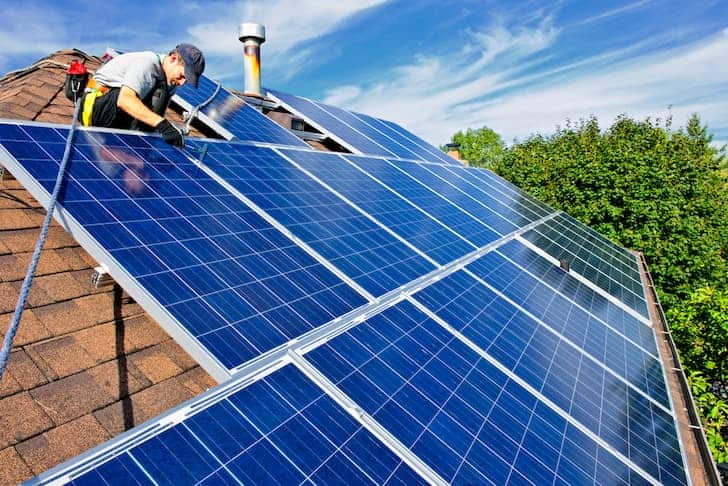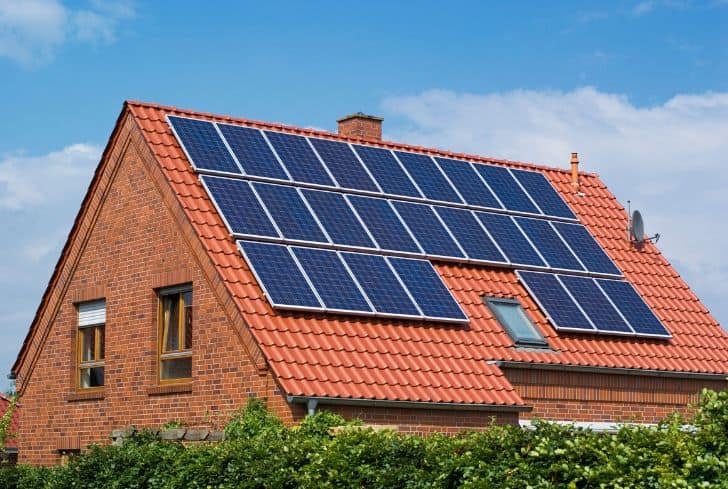The consumption of non-renewable sources like oil, gas and coal is increasing at an alarming rate. The time has finally come to look after some other renewable sources of energy, i.e., solar, wind and geothermal energy. Although many countries have started utilizing solar energy extensively, they still have to go a long way to exploit this renewable energy to fulfill their daily demand for energy.
With all the growing concerns about sustainable development all across the globe, the solar energy industry is bound to become a booming industry in a few years’ time. It will not only create several job openings for people but also it would help us in our eco-friendly survival as well.
It is no surprise that everyone is looking for some alternative energy source that would help them conserve the non-renewable resources a little better for their future generations. Solar energy is definitely the best go-to source of energy for them, and it is undeniably the future of our planet.
What is Solar Energy?
Solar energy refers to energy from the sun. The sun has produced energy for billions of years. It is the most important source of energy for life forms. It is a renewable source of energy, unlike non- renewable sources such as fossil fuels. Solar energy technologies use the sun’s energy to light homes, produce hot water, heat homes, as shown in solar tankless water heater reviews and electricity.
The main benefit of solar energy is that it does not produce any pollutants and is one of the cleanest sources of energy. It is a renewable source of energy, requires low maintenance and is easy to install. The only limitation that solar energy possesses is that it cannot be used at night, and the amount of sunlight that is received on earth depends on location, time of day, time of year, and weather conditions.
40+ Awesome Facts About Solar Energy You Can’t Afford to Miss
Here are a few facts on solar energy that can help you assess the potential of solar energy to meet global requirements.
Fact 1: Solar energy is a completely free source of energy, and it is found in abundance. Though the sun is 90 million miles from the earth, it takes less than 10 minutes for light to travel from that much distance.
Fact 2: Solar energy which comprises of radiant heat and light from the sun can be harnessed with some modern technology like photovoltaic cells, solar heating, artificial photosynthesis, solar architecture and solar thermal electricity.
Fact 3: Solar technology can be distinguished into active and passive. Photovoltaic panels and solar thermal collectors which harness solar energy are examples of active solar technology. Passive technology includes constructing rooms to improve air circulation, orienting space to use sunlight favorably.
Fact 4: The earth gets 174 Petawatts of incoming solar radiation in the upper atmosphere. About 30% is reflected back to space, and the rest is absorbed by oceans, clouds and landmasses.
Fact 5: The water cycle is an important result of solar insulation. The earth, oceans and atmosphere absorb solar radiation and their temperature rises. Warm air rises from the oceans, causing convection. When this air rises to high altitudes, clouds are created by condensation of water vapor. These clouds cause rains that bring water back to the earth’s surface, which completes the water cycle.
Fact 6: Solar energy also has another use. By means of photosynthesis, solar energy is converted into chemical energy by green plants, which creates the biomass that makes up fossil fuels.
Fact 7: Horticulture and agriculture seek to make the maximum use of solar energy. These include techniques like the timing of planting cycles and the mixing of plant varieties. Greenhouses are also used to convert light into heat to promote year-round cultivation of special crops.
Fact 8: Solar powered hot water systems utilize solar energy to heat water. In certain areas, 60 to 70% of the water used domestically for temperatures as high as 60 degrees Celsius can be made available by solar heating.
Fact 9: Solar chimneys are passive solar ventilation systems. Shafts connect the interior and exterior of the building. The functioning can be improved by glazing and using thermal mass materials.
Fact 10: Solar energy can also be used for making potable, brackish or saline water. Without using electricity or chemicals, wastewater can be treated. Creating salt from seawater is also one of the oldest uses of solar energy.
Fact 11: Clothes can be dried in the sun using clotheslines, cloth racks etc.
Fact 12: Food can be cooked, dried or pasteurized using solar energy.
Fact 13: Solar power is the most exciting use of solar energy. It is how solar energy is converted into electricity by using either photovoltaic (direct method) or concentrated solar power (indirect). Large beams of sunlight are focused into a small beam using mirrors or lenses in the case of concentrated solar power. The photoelectric effect is used by Photovoltaic to convert solar energy into electric energy.
Fact 14: Solar chemical processes replace fossil fuels as a source for chemical energy and can make solar energy storable and transportable. Photosynthesis can create a variety of fuels. Technology for producing Hydrogen is a major area of solar chemical research.
Fact 15: Thermal storage systems can store solar energy in the form of heat by using common materials with high specific heat such as stone, earth and water. Solar energy can also be stored in molten salts.
Fact 16: The oil crisis of 1970 revealed the delicate nature of fossil fuels as a source of energy for the world. As such, research in the alternative, renewable energy technology like that of solar and wind energy gained momentum.
Fact 17: Solar energy is being recognized as the future of alternative energy sources as it is non-polluting and helps combat the Greenhouse effect on the global climate created by the use of fossils fuels.
Fact 18: Common domestic use of solar energy is from solar panels that absorb solar energy to use for cooking and heating water.
Fact 19: Solar energy produces no pollution, has no environmental effects and is ecologically acceptable.
Fact 20: Solar energy is one of the most widely used renewable sources of energy. One can use renewable energy technologies to convert solar energy into electricity.
Fact 21: Space missions by various countries use solar energy to power their spaceships.
Fact 22: Solar energy is a very reliable source of energy.
Fact 23: With new advancements in scientific researches, solar energy could be more affordable in the future with decreasing costs and increasing efficiency.
Fact 24: Solar energy could prove to be the major source of renewable energy because of its massive potential and long-term advantages.
Fact 25: The earth receives about 1,366 watts of direct solar radiation per square meter.
Fact 26: The largest solar power plant in the world is located in the Mojave Desert in California, covering 1000 acres.
Fact 27: Solar energy is the preferred mode of creating power where the need is temporary. For e.g., temporary fairs, mining sites, Olympics.
Fact 28: Solar energy can also be used to power calculators.
Fact 29: Solar panels are virtually maintenance-free since the batteries require no water or other regular service and will last for years. Once solar panels are installed, there are no recurring costs.
Fact 30: Solar power can significantly reduce electricity bills. Moreover, there are many tax incentives and rebate programs designed to spur the use of solar and save homeowner’s money at the same time.
Fact 31: Solar power is free of noise pollution. It has no moving parts and does not require any additional fuel, other than sunlight, to produce power.
Fact 32: A home solar panel system consists of several solar panels, an inverter, a battery, a charge regulator, wiring, and support materials. Sunlight is absorbed by the solar panels and is converted to electricity by the installed system. The battery stores electricity that can be used at a later time, like cloudy days or during the evening.
Fact 33: By relying on battery backup, solar energy can even provide electricity 24×7, even on cloudy days and at night.
Fact 34: Solar Energy is measured in kilowatt-hour. 1 kilowatt = 1000 watts.
Fact 35: Though solar energy is used on a wide scale, it only provides a small fraction of the world’s energy supply.
Fact 36: Solar energy is used in many applications, including Electricity, Evaporation, Biomass, Heating water and buildings and even Transport.
Fact 37: Large investment is one of the primary reasons why solar energy is still not used by many people all over the world.
Fact 38: Solar energy has been used for over 2700 years. In 700 BC, glass lenses were used to make fire by magnifying the sun’s rays.
Fact 39: The sun is also the main source of non-renewable fossil fuels (coal, gas and petroleum), which began life as plants and animals millions of years ago.
Fact 40: Clouds and pollution prevent the sun’s rays from reaching the earth.
Every year the sun beams to the earth’s energy to sustain global needs of energy for the entire year. Solar energy is a technology used to convert solar energy into other forms, like electrical energy to meet global requirements. As of now, only one-tenth of global energy needs is supplied by solar energy, but the potential for the future is mind-boggling.
Fact 41: Solar energy is one of the most abundant sources of energy. It is no wonder that the sun holds enough energy to satiate the energy requirement of the entire world. If taken seriously and harnessed properly, humankind would never again require any other non-renewable sources of energy to fuel its requirements. In fact, as the usage of solar energy increases, the earth gradually becomes a more sustainable place to live in.
Fact 42: If the Mojave Desert is lined up with arrays of solar panels, harvesting solar energy there for a day, would generate more energy than the United States uses electricity annually. In fact, the amount of solar energy produced is actually twice the annual electricity usage in the US. Which means not only will it save a lot of money, but also, it will decrease the use of the non-renewable resources of fossil fuels by leaps and bounds.
Fact 43: Believe it or not, the cost of the solar panels has reduced by a staggering 99% since 1977. Solar panels are quintessential for the purpose of harvesting solar energy. According to the market reports of Solar Energy Industries Association and GTM Research, the cost of a solar cell now is just $0.21 per watt as compared to the $77 per watt of 1977. An entire assembled module costs just $0.39 per watt in recent years.
Fact 44: It might be a little difficult to believe at first, but the fact is that solar energy is cheaper than fossil fuels. Solar energy approximately costs as little as 4.3 cents per kWh on unsubsidized terms. It’s hard to believe, is it not? This makes solar energy way cheaper than any other fossil fuel alternatives, which costs something between 4.2 cents per kWh to 7.8 cents per kWh. So your savings are really big.
Fact 45: When a solar power plant has been established, the power supply contract that it makes with its customers last for a span of approximately 20 to 25 years. This means that, once it has been established, a solar energy plant has to last for more than two decades.
Also, the solar panels might be good to go for a total of 40 to 50 years. After that, they could be replaced with panels that are more developed and with better efficiency. Installation of the solar panels can be really costly; however, they are absolutely worth it. They are both- energy as well as cost-efficient. All in all, they are a very wise and a very valuable investment.
Bonus fact: Solar energy is in a rapid growth in Sweden each year growing by 96%.







